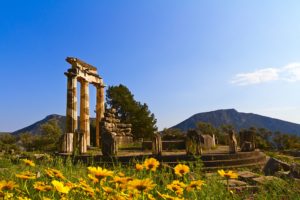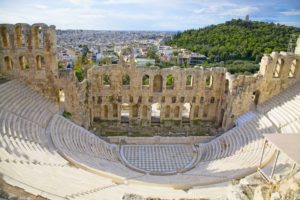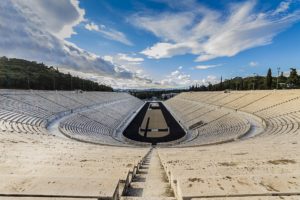Benaki Museum ranks among the major institutions in Greece and is the oldest museum in the country to operate as a private foundation. The Benaki Museum was established and endowed in 1930 by Antonis Benakis in memory of his father, Emmanuel Benakis. It is housed in the Benakis family mansion in downtown Athens, Greece.
The museum houses Greek works of art from the prehistorical to modern times. Also, it has an extensive collection of Asian art, hosts periodic exhibitions and maintains a state-of-the-art restoration and conservation workshop. Although the museum initially housed a collection that included Islamic art, Chinese porcelain, and exhibits on toys, its 2000 re-opening led to the creation of satellite museums that focused on specific collections. That allowed the main museum to focus on Greek culture throughout the country’s history.
History of the Museum
The museum’s primary home is in the Benakis’ house opposite the National Garden on Queen Sofias Avenue. It owes its existence to the generosity of Antonis Benakis, whose family lived in Alexandria, Egypt.
In 1931, the Benakis donated the family’s house in Athens and their collection of more than 37,000 Islamic and Byzantine objects. More than 9,000 artifacts were added by the 1970s, which spurred donations from other sources. Benakis remained active in the museum until his death in 1954.
2000 re-opening
In 2000, the Benaki Museum reopened following a $20 million renovation and restoration of the building. The repair was essential due to the damages of an earthquake. The renovation allowed it to become the only museum in Greece that brings visitors through all ages of Greek culture and history. It is also unique in that it does not focus on nationalism but instead recognizes and celebrates the foreign influences on Greek culture.
Although the museum’s director, Angelos Delivorrias, came up with the idea to refocus the museum and its exhibits in 1973, more than 25 years passed before he was able to make this new reality. This involved moving the museum’s collections of Islamic Art and Chinese porcelain with painting to other locations so that the main museum in Athens would focus solely on Greece.
Satellite museums
Over the years the museum has been further endowed by various donors. The Museum now includes the seaside Kouloura Mansion in Palaio Phaliro, which is to house a Children’s Toys Collection, the Benaki Islamic Art Museum in the Kerameikos district, the Nikos Hadjikyriakos-Ghikas Museum in downtown Athens, and the Penelope Delta House in Kifissia, which houses the Historical Archive Collection.
Benaki Islamic Art Museum
As part of the museum’s re-focusing on Greek culture, its Islamic collection moved to a new home in 2004 in time for the Athens Olympics. The new museum includes new galleries for temporary traveling exhibits.
Inaugurated on 27 July 2004, the museum occupies more than 1,000 square meters of remodeled space showcasing: ceramics, pottery, metalwork, gold, woodcarvings, glasswork and textiles, bone carvings, inscribed funerary steles, arms, and armor. The museum’s collection is said to rank among the most important worldwide and includes masterpieces from India, Persia, Mesopotamia, the Middle East, Arabia, Egypt, North Africa, Sicily, Spain, and Asia Minor. Covering Islamic art from the 7th through the 19th centuries, it has a rich collection of Ottoman art from the Empire’s peak in the 16th century
The Museum building
The Benaki Museum occupies one of the few neoclassical buildings that continue to resist the aesthetic deterioration of postwar Athens. It is located in an exceptionally favorable location in the historic center of the city, right opposite the lush greenery of the National Gardens and the garden of the Presidential Mansion. In the same vicinity, you may also find the related institutions such as the Museum of Cycladic Art and the Byzantine and Christian Museum.
The building at 138 Pireos Street
The new Benaki Museum building is located at 138 Pireos Street, one of the central development axes of Athens.
The existing building, which is organized around a central courtyard, is already being refurbished, thanks to co-funding by the Ministry of Culture and the European Union.
The new building covers a total area of 8,200 m2 with underground areas of 2,800 m2 and an internal courtyard of 850 m2. The exhibition halls span 3,000 m2. There is an amphitheater capable of seating 300, as well as areas to house the Museum services.
The architectural renovation preserved the initial building plan and added a floor. The general principles of the design were based on the idea of an inward-facing structure with openings towards the central courtyard. Movement through the exhibition halls is designed to take place around the perimeter of the courtyard, in such a way as to ensure maximum visibility for the visitor and flexibility in the utilization of space. The atrium/courtyard area, a primary feature of the activities taking place there, can host outdoor exhibitions, musical events, and performances. The bookshop and restaurant open onto the courtyard at the ground level.
The spatial organization and the style of the building aim to create a place where a short, simple visit will not suffice. Thus the building will operate throughout the day, offering visitors comfortable conditions for their tour and an opportunity to attend alternative events, or just to have a cup of coffee.
The building complex in Kerameikos
The Islamic art collections of the Benaki Museum are housed in a complex of neo-classical buildings located in the historical center of Athens, in the Kerameikos district. Major archaeological sites located in the same area include the grounds of the ancient Agora (currently undergoing development), the Doric temple of Hephaestus (the “Theseio”) and the Museum of the ancient Kerameikos necropolis (cemetery).
This complex of buildings at the corner of Agion Asomaton and Dipylou streets was donated to the Museum by the late Lambros Eftaxias, who in his later years served as Honorary President of the Museum Board of Trustees.
The complex comprises a three-storey house and a two-storey house, the facades of which were listed in 1989. In 1996, from the officially approved architectural and structural design drawn up for the Benaki Museum by the architect P. Kalligas and the civil engineer G. Sparis. The Directorate of Special Works of the Ministry of the Environment, Town Planning and Public Works undertook works to reinforce the two buildings and to strengthen the ornamental features of their facades, as a part of the program for the redevelopment of the Kerameikos district.
During these preservation works, a section of the ancient city wall of Athens and an ancient tomb were uncovered at the level of the houses’ foundations. Following discussions between the Museum and the 3rd Ephorate of Prehistoric and Classical Antiquities, it was decided that the finds should remain in situ and the area at basement level should be re-designed so as to make them accessible to visitors. To this end, the initial design was immediately modified to allow for the finds made during excavation work to be preserved following contemporary methods of presenting associated cultural remains.
More info about opening hours and exhibitions here.


